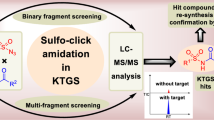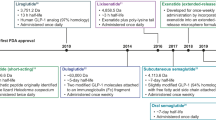Abstract
Current understanding of the molecular basis of activation of class II G protein-coupled receptors remains limited, despite recent solution of NMR and crystal structures of amino-terminal domains of several family members. One mechanism proposed for the activation of these receptors involves an agonist-stimulated change in conformation of the receptor amino terminus. This results in the exposure of a “hidden endogenous agonist” (WDN sequence in secretin and VPAC1 receptors) within the receptor amino terminus that interacts with the receptor core, thereby changing its conformation and exposing its G protein-binding region. The Asn in this WDN sequence is known to be glycosylated in both secretin and VPAC1 receptors, raising concern about whether this posttranslational modification might interfere with the proposed mechanism. Therefore, we prepared glycosylated forms of cyclic WDN and the longer cyclic peptide, LWDNM, and tested them for agonist activity at secretin and VPAC1 receptor-bearing cell lines. Both glycosylated peptides stimulated full cAMP responses in the cell lines. Clearly, glycosylation did not interfere with this mechanism and may actually facilitate the correct orientation of the pharmacophore of the endogenous agonist ligand. These data provide further evidence for this proposed mechanism for the activation of this family of receptors.



Similar content being viewed by others
References
Bisello, A., Adams, A. E., Mierke, D. F., et al. (1998). Parathyroid hormone-receptor interactions identified directly by photocross-linking and molecular modeling studies. Journal of Biological Chemistry, 273, 22498–22505.
Carruthers, C. J., Unson, C. G., Kim, H. N., & Sakmar, T. P. (1994). Synthesis and expression of a gene for the rat glucagon receptor. Replacement of an aspartic acid in the extracellular domain prevents glucagon binding. Journal of Biological Chemistry, 269, 29321–29328.
Couvineau, A., Gaudin, P., Maoret, J. J., Rouyer-Fessard, C., Nicole, P., & Laburthe, M. (1995). Highly conserved aspartate 68, tryptophane 73 and glycine 109 in the N-terminal extracellular domain of the human VIP receptor are essential for its ability to bind VIP. Biochemical and Biophysical Research Communications, 206, 246–252.
Dong, M., Lam, P. C., Gao, F., et al. (2007). Molecular approximations between residues 21 and 23 of secretin and its receptor: Development of a model for peptide docking with the amino terminus of the secretin receptor. Molecular Pharmacology, 72, 280–290.
Dong, M., Li, Z., Pinon, D. I., Lybrand, T. P., & Miller, L. J. (2004a). Spatial approximation between the amino terminus of a peptide agonist and the top of the sixth transmembrane segment of the secretin receptor. Journal of Biological Chemistry, 279, 2894–2903.
Dong, M., Pinon, D. I., Asmann, Y. W., & Miller, L. J. (2006). Possible endogenous agonist mechanism for the activation of secretin family G protein-coupled receptors. Molecular Pharmacology, 70, 206–213.
Dong, M., Pinon, D. I., Cox, R. F., & Miller, L. J. (2004b). Molecular approximation between a residue in the amino-terminal region of calcitonin and the third extracellular loop of the class B G protein-coupled calcitonin receptor. Journal of Biological Chemistry, 279, 31177–31182.
Godfrey, P., Rahal, J. O., Beamer, W. G., Copeland, N. G., Jenkins, N. A., & Mayo, K. E. (1993). GHRH receptor of little mice contains a missense mutation in the extracellular domain that disrupts receptor function. Nature Genetics, 4, 227–232.
Grace, C. R., Perrin, M. H., DiGruccio, M. R., et al. (2004). NMR structure and peptide hormone binding site of the first extracellular domain of a type B1 G protein-coupled receptor. Proceedings of the National Academy of Sciences of the United States of America, 101, 12836–12841.
Grace, C. R., Perrin, M. H., Gulyas, J., et al. (2007). Structure of the N-terminal domain of a type B1 G protein-coupled receptor in complex with a peptide ligand. Proceedings of the National Academy of Sciences of the United States of America, 104, 4858–4863.
Harikumar, K. G., Lam, P. C., Dong, M., Sexton, P. M., Abagyan, R., & Miller, L. J. (2007). Fluorescence resonance energy transfer analysis of secretin docking to its receptor: Mapping distances between residues distributed throughout the ligand pharmacophore and distinct receptor residues. Journal of Biological Chemistry, 282, 32834–32843.
Horton, D., & Wolfrom, M. L. (1962). Thiosugars. I. Synthesis of derivatives of 2-amino-2-deoxyl-1-thio-d-glucose. Journal of Organic Chemistry, 27, 1794–1800.
Laburthe, M., Couvineau, A., & Tan, V. (2007). Class II G protein-coupled receptors for VIP and PACAP: Structure, models of activation and pharmacology. Peptides, 28, 1631–1639.
Lin, S. C., Lin, C. R., Gukovsky, I., Lusis, A. J., Sawchenko, P. E., & Rosenfeld, M. G. (1993). Molecular basis of the little mouse phenotype and implications for cell type-specific growth. Nature, 364, 208–213.
Mayo, K. E., Miller, L. J., Bataille, D., et al. (2003). International union of pharmacology. XXXV. The glucagon receptor family. Pharmacological Reviews, 55, 167–194.
Parthier, C., Kleinschmidt, M., Neumann, P., et al. (2007). Crystal structure of the incretin-bound extracellular domain of a G protein-coupled receptor. Proceedings of the National Academy of Sciences of the United States of America, 104, 13942–13947.
Powers, S. P., Pinon, D. I., & Miller, L. J. (1988). Use of N,O-bis-Fmoc-d-Tyr-ONSu for introduction of an oxidative iodination site into cholecystokinin family peptides. International Journal of Peptide and Protein Research, 31, 429–434.
Sun, C., Song, D., Davis-Taber, R. A., et al. (2007). Solution structure and mutational analysis of pituitary adenylate cyclase-activating polypeptide binding to the extracellular domain of PAC1-RS. Proceedings of the National Academy of Sciences of the United States of America, 104, 7875–7880.
Tan, Y. V., Couvineau, A., Murail, S., et al. (2006). Peptide agonist docking in the N-terminal ectodomain of a class II G protein-coupled receptor, the VPAC1 receptor. Photoaffinity, NMR, and molecular modeling. Journal of Biological Chemistry, 281, 12792–12798.
Ulrich, C. D. 2nd, Ferber, I., Holicky, E., Hadac, E., Buell, G., & Miller, L. J. (1993a). Molecular cloning and functional expression of the human gallbladder cholecystokinin A receptor. Biochemical and Biophysical Research Communications, 193, 204–211.
Ulrich, C. D. 2nd, Pinon, D. I., Hadac, E. M., et al. (1993b). Intrinsic photoaffinity labeling of native and recombinant rat pancreatic secretin receptors. Gastroenterology, 105, 1534–1543.
Yamamoto, A., Miyashita, C., & Tsukamoto, H. (1965). Studies on amino sugars I. Preparation of N-acyl derivatives of 2-acetamido-2-deoxy-beta-d-glycosylamine. Chemical and Pharmaceutical Bulletin (Tokyo), 13, 1036–1041.
Acknowledgements
The authors acknowledge the excellent technical assistance of L.A. Bruins and the secretarial assistance of E. Posthumus. This study was supported by a grant from the National Institutes of Health, DK46577, and by the Fiterman Foundation and Mayo Clinic.
Author information
Authors and Affiliations
Corresponding authors
Rights and permissions
About this article
Cite this article
Dong, M., Pinon, D.I. & Miller, L.J. Exploration of the Endogenous Agonist Mechanism for Activation of Secretin and VPAC1 Receptors Using Synthetic Glycosylated Peptides. J Mol Neurosci 36, 254–259 (2008). https://doi.org/10.1007/s12031-008-9058-6
Received:
Accepted:
Published:
Issue Date:
DOI: https://doi.org/10.1007/s12031-008-9058-6




